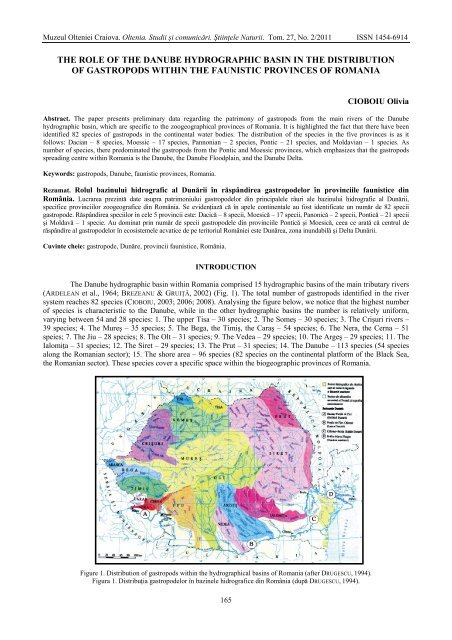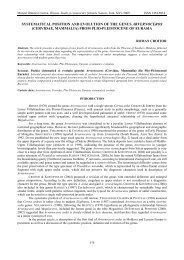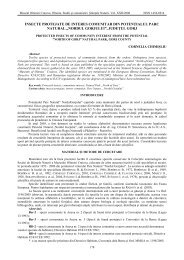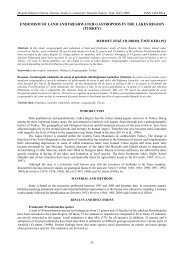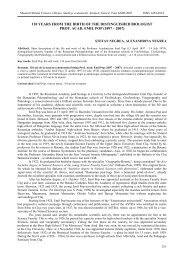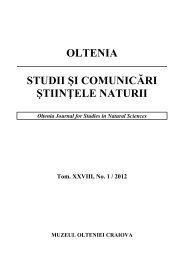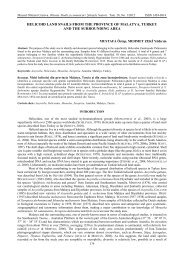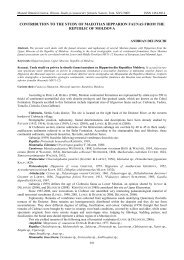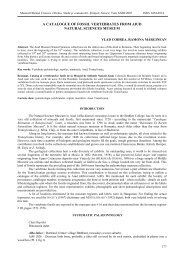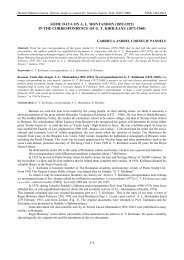Download - Oltenia, Studii si Comunicari, Stiintele Naturii
Download - Oltenia, Studii si Comunicari, Stiintele Naturii
Download - Oltenia, Studii si Comunicari, Stiintele Naturii
Create successful ePaper yourself
Turn your PDF publications into a flip-book with our unique Google optimized e-Paper software.
Muzeul Olteniei Craiova. <strong>Oltenia</strong>. <strong>Studii</strong> i comunicri. tiinele <strong>Naturii</strong>. Tom. 27, No. 2/2011 ISSN 1454-6914<br />
THE ROLE OF THE DANUBE HYDROGRAPHIC BASIN IN THE DISTRIBUTION<br />
OF GASTROPODS WITHIN THE FAUNISTIC PROVINCES OF ROMANIA<br />
CIOBOIU Olivia<br />
Abstract. The paper presents preliminary data regarding the patrimony of gastropods from the main rivers of the Danube<br />
hydrographic ba<strong>si</strong>n, which are specific to the zoogeographical provinces of Romania. It is highlighted the fact that there have been<br />
identified 82 species of gastropods in the continental water bodies. The distribution of the species in the five provinces is as it<br />
follows: Dacian – 8 species, Moes<strong>si</strong>c – 17 species, Pannonian – 2 species, Pontic – 21 species, and Moldavian – 1 species. As<br />
number of species, there predominated the gastropods from the Pontic and Moes<strong>si</strong>c provinces, which empha<strong>si</strong>zes that the gastropods<br />
spreading centre within Romania is the Danube, the Danube Floodplain, and the Danube Delta.<br />
Keywords: gastropods, Danube, faunistic provinces, Romania.<br />
Rezumat. Rolul bazinului hidrografic al Dunrii în rspândirea gastropodelor în provinciile faunistice din<br />
România. Lucrarea prezint date asupra patrimoniului gastropodelor din principalele râuri ale bazinului hidrografic al Dunrii,<br />
specifice provinciilor zoogeografice din România. Se evideniaz c în apele continentale au fost identificate un numr de 82 specii<br />
gastropode. Rspândirea speciilor în cele 5 provincii este: Dacic – 8 specii, Moe<strong>si</strong>c – 17 specii, Panonic – 2 specii, Pontic – 21 specii<br />
i Moldav – 1 specie. Au dominat prin numr de specii gastropodele din provinciile Pontic i Moe<strong>si</strong>c, ceea ce arat c centrul de<br />
rspândire al gastropodelor în eco<strong>si</strong>stemele acvatice de pe teritoriul României este Dunrea, zona inundabili Delta Dunrii.<br />
Cuvinte cheie: gastropode, Dunre, provincii faunistice, România.<br />
INTRODUCTION<br />
The Danube hydrographic ba<strong>si</strong>n within Romania comprised 15 hydrographic ba<strong>si</strong>ns of the main tributary rivers<br />
(ARDELEAN et al., 1964; BREZEANU & GRUI, 2002) (Fig. 1). The total number of gastropods identified in the river<br />
system reaches 82 species (CIOBOIU, 2003; 2006; 2008). Analy<strong>si</strong>ng the figure below, we notice that the highest number<br />
of species is characteristic to the Danube, while in the other hydrographic ba<strong>si</strong>ns the number is relatively uniform,<br />
varying between 54 and 28 species: 1. The upper Tisa – 30 species; 2. The Some – 30 species; 3. The Criuri rivers –<br />
39 species; 4. The Mure – 35 species; 5. The Bega, the Timi, the Cara – 54 species; 6. The Nera, the Cerna – 51<br />
speies; 7. The Jiu – 28 species; 8. The Olt – 31 species; 9. The Vedea – 29 species; 10. The Arge – 29 species; 11. The<br />
Ialomia – 31 species; 12. The Siret – 29 species; 13. The Prut – 31 species; 14. The Danube – 113 species (54 species<br />
along the Romanian sector); 15. The shore area – 96 species (82 species on the continental platform of the Black Sea,<br />
the Romanian sector). These species cover a specific space within the biogeographic provinces of Romania.<br />
Figure 1. Distribution of gastropods within the hydrographical ba<strong>si</strong>ns of Romania (after DRUGESCU, 1994).<br />
Figura 1. Distribuia gastropodelor în bazinele hidrografice din România (dup DRUGESCU, 1994).<br />
165
CIOBOIU Olivia<br />
By analy<strong>si</strong>ng the po<strong>si</strong>tion of the hydrographic ba<strong>si</strong>ns of the main rivers, it results that the Danube and the<br />
lower sectors of the Jiu, the Olt, the Arge, the Ialomia rivers belong to the Moes<strong>si</strong>c province. The lower sector of the<br />
Danube, starting from the mouth of the Arge and the lower part of the Siret ba<strong>si</strong>n, as well as the small streams from<br />
Dobroudja belong to the Pontic province. Most of the rivers from Romania are located within the Dacian province.<br />
Among these, we mention the Mure, the upper sectors of the main tributaries of the Danube (the Jiu, the Olt, the Arge,<br />
the Ialomia). The Prut River is placed in the Moldavian province, while the Criuri rivers, the Bega, the Nera, the<br />
Cara, the Cerna rivers are included in the Pannonian province (BNRESCU, 1970; CLINESCU et al., 1972) (Fig. 2).<br />
Figure 2. Biogeographic regions of Romania (after CLINESCU et al., 1972).<br />
Figura 2. Regionarea biogeografic a României (dup CLINESCU et al., 1972).<br />
MATERIAL AND METHODS<br />
In order to globally evaluate the diver<strong>si</strong>ty and distribution of the species, there was performed an inventory of<br />
the aquatic gastropods patrimony in the five Romanian faunistic provinces. For rendering the specific features of the<br />
aquatic ecosystems gastropods live in and empha<strong>si</strong>zing their distribution within the zoogeographical provinces, there<br />
were taken qualitative and quantitative samples from the Danube and its tributaries, the Jiu, the Olt, and the Arge.<br />
Within this framework, it has been achieved a synthe<strong>si</strong>s of the zoogeographical distribution of the fresh water<br />
gastropods on the territory of Romania for the first time (BNRESCU, 1990; BNRESCU & BOCAIU, 1973; COSTACHE,<br />
1996; DRUGESCU, 1994).<br />
RESULTS AND DISCUSSIONS<br />
Following the distribution of the gastropods on faunistic provinces, it results that out of the total number of 82<br />
species located within all the rivers, 8 species are characteristic to the Dacian province, 17 to the Moes<strong>si</strong>c province, 2 to<br />
the Pannonian province, 21 to the Pontic province, and one species to the Moldavian province (Table 1).<br />
Table 1. Distribution of the gastropods characteristic to the faunistic provinces of Romania.<br />
Tabel 1. Rspândirea gastropodelor caracteristice în provinciile faunistice din România.<br />
No.<br />
Species<br />
Faunistic provinces of Romania<br />
Dacian Moes<strong>si</strong>c Pannonian Pontic Moldavian<br />
1. Theodoxus (Th.) danubialis (C. PFEIFFER 1828) + + + + +<br />
2. Theodoxus (Th.) d. stragulatus (C. PFEIFFER 1828) +<br />
3. Theodoxus (Th.) euxinus (CLESSIN 1887) +<br />
4. Theodoxus (Th.) fluviatilis (LINNAEUS 1758) + +<br />
5. Theodoxus (Th.) palla<strong>si</strong> LINDHOLM 1924 +<br />
6. Theodoxus (Th.) prevostianus (C. PFEIFFER 1828) +<br />
7. Theodoxus (Th.) transversalis (C. PFEIFFER 1828) + + +<br />
8. Viviparus acerosus (BOURGUIGNAT 1862) + + + + +<br />
9. Viviparus contectus (MILLET 1813) + +<br />
166
Muzeul Olteniei Craiova. <strong>Oltenia</strong>. <strong>Studii</strong> i comunicri. tiinele <strong>Naturii</strong>. Tom. 27, No. 2/2011 ISSN 1454-6914<br />
10. Viviparus viviparus (LINNAEUS 1758) + +<br />
11. Valvata (Cincinna) piscinalis (O. F. MULLER 1774) + + + + +<br />
12. Valvata (Cincinna) piscinalis antiqua MORRIS 1838 +<br />
13. Valvata (Valvata) cristata O. F. MULLER 1774 + +<br />
14. Borysthenia naticina (MENKE 1845) + +<br />
15. Pseudamnicola (P.) dobrogica GROSSU 1986 +<br />
16. Pseudamnicola (P.) leontina GROSSU 1986 +<br />
17. Pseudamnicola (P.) penchinati (BOURGUIGNAT 1870) +<br />
18. Pseudamnicola (P.) razelmiana GROSSU 1986 +<br />
19. Pseudamnicola (P.) bacescui GROSSU 1986 +<br />
20. Grossuana codreanui GROSSU 1946 +<br />
21. Paladilhia (Paladilhiop<strong>si</strong>s) transsylvanica ROTARIDES 1943 +<br />
22. Paladilhia (Paladilhiop<strong>si</strong>s) carpathica SOOS 1940 +<br />
23. Paladilhia (Paladilhiop<strong>si</strong>s) leruthi C. R. BOETGER 1940 +<br />
24. Bythinella austriaca (FRAUENFELD 1857) +<br />
25. Bythinella a. melanostroma BRANCSIK 1889 +<br />
26. Bythinella dacica (GROSSU 1946) +<br />
27. Bythinella grossui FALNIOWSKI, SZAROWSKA & SÎRBU 2009 +<br />
28. Bythinella molcsany (J. WAGNER 1941) +<br />
29 Potamopyrgus jenkin<strong>si</strong> (SMITH 1889) +<br />
30. Lithoglyphus apertus (KUSTER 1852) +<br />
31. Lithoglyphus naticoides (C. PFEIFFER 1828) + + +<br />
32. Lithoglyphus pygmaeus FRAUENFELD 1863 +<br />
33. Bithynia (Bithynia) tentaculata (LINNAEUS 1758) + + + + +<br />
34. Bithynia (Codiella) leachii (SHEPPARD 1823) + + + + +<br />
35. Bithynia (Codiella) troschelli (PAASCH 1842) + +<br />
36. Turricaspia (Cles<strong>si</strong>niola) variabilis (EICHWALD 1838) +<br />
37. T. (Laevicaspia) lincta (MILASCHEWITCH 1908) +<br />
38. T. (Oxypyrgula) ismailen<strong>si</strong>s (GOL. & STAROB. 1966) +<br />
39. T. (Turricaspia) dimidiata (EICHWALD 1841) +<br />
40. T. (Micromelania) ostroumovi (GOL. & STAROB. 1966) +<br />
41. Melanop<strong>si</strong>s parreys<strong>si</strong> PHILIPPI 1847 +<br />
42. Esperiana esperi (A. FERUSSAC 1823) + + + + +<br />
43. E. (Microcolpia) daudebardii (PREVOST 1821) + + + + +<br />
44. E. (Microcolpia) daudebardii acicularis (FERUSSAC 1823) + +<br />
45. Amphimelania holandri (C. PFEIFFER 1828) +<br />
46. Physa fontinalis (LINNAEUS 1758) + + + + +<br />
47. Physella (Costatella) acuta (DRAPARNAUD 1805) + + + + +<br />
48. Aplexa hypnorum (LINNAEUS 1758) + + + + +<br />
49. Lymnaea stagnalis (LINNAEUS 1758) + + + + +<br />
50. Stagnicola corvus (GMELIN 1791) + + + + +<br />
51. Stagnicola palustris (O. F. MULLER 1774) + + + + +<br />
52. Stagnicola turricula HELD 1836 + +<br />
53. Radix ampla (W. HARTMANN 1821) + + +<br />
54. Radix auricularia (LINNAEUS 1758) + + + + +<br />
55. Radix balthica (LINNAEUS 1758) + + + + +<br />
56. Radix labiata (ROSSMASSLER 1835) + + + + +<br />
57. Galba truncatula (O. F. MULLER 1774) + + + + +<br />
58. Ancylus fluviatilis O. F. MULLER 1774 + +<br />
59. Ferris<strong>si</strong>a (Pettancylus) cles<strong>si</strong>niana (JICKELI 1882) + +<br />
60. Acroloxus lacustris (LINNAEUS 1758) + + + + +<br />
61. Planorbis (Planorbis) carinatus O. F. MULLER 1774 + + + + +<br />
62. Planorbis (Planorbis) planorbis (LINNAEUS 1758) + + + + +<br />
63. Biomphalaria tenogophila (ORBIGNY 1835) + +<br />
64. Anisus (Anisus) calculiformis (SANDBERGER 1874) +<br />
65. Anisus (Anisus) leucostoma (MILLET 1813) + +<br />
66. Anisus (Anisus) septemgyratus (ROSSMASSLER 1835) + + + + +<br />
67. Anisus (Anisus) spirorbis (LINNAEUS 1758) + + + + +<br />
68. Anisus (Disculifer) vortex (LINNAEUS 1758) + + + + +<br />
69. Anisus (Disculifer) vorticulus TROSCHEL 1852 + + +<br />
70. Bathyomphalus contortus (LINNAEUS 1758) + + + + +<br />
71. Gyraulus (Armiger) crista LINNAEUS 1758 + + + + +<br />
72. Gyraulus (Gyraulus) acronicus (A. FERUSSAC 1807) + + + + +<br />
73. Gyraulus (Gyraulus) albus (O. F. MULLER 1774) + + + + +<br />
74. Gyraulus (Torquis) laevis (ALDER 1838) + + + + +<br />
75. Gyraulus (Lamorbis) rossmaessleri (AUERSWALD 1852) + +<br />
76. Hippeutis complanatus (LINNAEUS 1758) + + + + +<br />
77. Segmentina nitida (O. F. MULLER 1774) + + + + +<br />
78. Planorbarius corneus (LINNAEUS 1758) + + + + +<br />
79. Planorbella duryi (WETHERBY 1879) + +<br />
80. Oxyloma (Oxyloma) dunkeri (L. PFEIFFER 1865) + +<br />
81. Oxyloma (Oxyloma) elegans (RISSO 1826) + +<br />
82. Oxyloma (Oxyloma) pinteri GROSSU 1987 + + + +<br />
167
CIOBOIU Olivia<br />
The Dacian Province is the largest zoogeographical unit on the territory of our country and includes the entire<br />
mountain region and partially the hilly region. Most of the species living in this province display a Central-European<br />
distribution. The main gastropods characteristic to the province are (GROSSU, 1946; GROSSU & NEGREA, 1984;<br />
FALNIOWSKI et al., 2009): Valvata (V.) cristata O. F. MULLER 1774, Paladilhia (Paladilhiop<strong>si</strong>s) transsylvanica<br />
ROTARIDES 1943, P. (P.) carpathica SOOS 1940, P. (P.) leruthi C. R. BOETGER 1940, Bythinella austriaca<br />
(FRAUENFELD 1857), B. dacica (GROSSU 1946), B. grossui FALNIOWSKI, SZAROWSKA & SÎRBU, 2009; B. molcsany (J.<br />
WAGNER 1941).<br />
The Moes<strong>si</strong>c Province includes the high and low plains, as well as the hilly or even the mountain regions from<br />
Banat, <strong>Oltenia</strong>, Muntenia and North and South Dobroudja. Most of the fauna present in this province is made up of<br />
species that usually live in the plain and hilly regions of the country and are common to all the zoogeographical<br />
provinces (GROSSU, 1955; BOTONEANU & NEGREA, 1976). Aquatic gastropods developed in a <strong>si</strong>gnificant number in<br />
this province. Thus, we mention the species – Theodoxus (Th.) d. stragulatus (C. PFEIFFER 1828), Th. (Th.)<br />
transversalis (C. PFEIFFER 1828), Viviparus viviparus (LINNAEUS 1758), Valvata (Cincinna) piscinalis antiqua MORRIS<br />
1838, Borysthenia naticina (MENKE 1845), Lithoglyphus apertus (KUSTER 1852), L. pygmaeus FRAUENFELD 1863,<br />
Bithynia (Codiella) troschelli (PAASCH 1842), Esperiana (Microcolpia) daudebardii acicularis (FERUSSAC 1823),<br />
Amphimelania holandri (C. PFEIFFER 1828), Physella (Costatella) acuta (DRAPARNAUD 1805), Stagnicola palustris (O.<br />
F. MULLER 1774), Radix ampla (W. HARTMANN 1821), R. labiata (ROSSMASSLER 1835), Galba truncatula (O. F.<br />
MULLER 1774), Ancylus fluviatilis O. F. MULLER 1774, Ferris<strong>si</strong>a (Pettancylus) cles<strong>si</strong>niana (JICKELI 1882),<br />
Biomphalaria tenogophila (ORBIGNY 1835), Anisus (Anisus) leucostoma (MILLET 1813), Anisus (Disculifer) vorticulus<br />
TROSCHEL 1852, Gyraulus (Gyraulus) albus (O. F. MULLER 1774), Gyraulus (Lamorbis) rossmaessleri (AUERSWALD<br />
1852), Planorbella duryi (WETHERBY 1879).<br />
Ancylus fluviatilis, a specific reophilic form, was quite often identified on the river rocks in Banat, at the mouth<br />
of the Danube tributaries (BNRESCU & SÎRBU, 2002). Radix ampla and R. labiata, more or less limnophilous species,<br />
appear in the areas with still water, where aquatic vegetation finds appropriate development conditions. In the springs<br />
located on the valleys of the Mraconia and Berzeasca rivers, the species Radix labiata was identified in a biocoeno<strong>si</strong>s<br />
on the sandy bottoms in moss.<br />
In the components of the biocoenoses from permanent or temporary stagnant waters, gastropods make up<br />
relatively dense populations, which develop in almost all the pools located in the Iron Gates area. In this province, there<br />
were also identified the species belonging to the Planorbis and Anisus genus, as well as the species Amphimelania<br />
holandri (NEGREA, 1994).<br />
The Pannonian Province is located in Banat-Crisana Plain, in the west of our country. In terms of age, it is<br />
younger than the Dacian province. From the phy<strong>si</strong>cal-geographical point of view, it covers a flat surface with forest<br />
steppe vegetation (oak forests, Turkish and Hungarian oak alternating with gramineous plants), rivers characterized by a<br />
high discharge and a moderate continental climate (BOTONEANU & NEGREA, 1976; BNRESCU & ARION, 1982;<br />
GROSSU, 1986). The gastropods from this province are represented by the species Theodoxus (Th.) prevostianus (C.<br />
PFEIFFER 1828) and Melanop<strong>si</strong>s parreys<strong>si</strong> PHILIPPI 1847.<br />
The Pontic Province covers the low plain and hilly regions from Brgan, Dobroudja Plateau, and Covurlui<br />
Plain (GROSSU, 1939; CIOBOIU, 2003). In this province, there were identified the most numerous aquatic gastropod<br />
species from Romania – Theodoxus (Th.) euxinus (CLESSIN 1887), Th. (Th.) fluviatilis (LINNAEUS 1758), Th. (Th.)<br />
palla<strong>si</strong> LINDHOLM 1924, Viviparus contectus (MILLET 1813) (Ponto-Dacian species), Pseudamnicola (P.) dobrogica<br />
GROSSU 1986, P. (P.) leontina GROSSU 1986, P. (P.) penchinati (BOURGUIGNAT 1870), P. (P.) razelmiana GROSSU<br />
1986, P. (P.) bacescui GROSSU 1986, Grossuana codreanui GROSSU 1946, Bythinella a. melanostroma BRANCSIK<br />
1889, Potamopyrgus jenkin<strong>si</strong> (SMITH 1889), Turricaspia (Cles<strong>si</strong>niola) variabilis (EICHWALD 1838), T. (Laevicaspia)<br />
lincta (MILASCHEWITCH 1908), T. (Oxypyrgula) ismailen<strong>si</strong>s (GOL. & STAROB. 1966), T. (Turricaspia) dimidiata<br />
(EICHWALD 1841), T. (Micromelania) ostroumovi (GOL. & STAROB. 1966), Esperiana esperi (A. FERUSSAC 1823),<br />
Hippeutis complanatus (LINNAEUS 1758), Oxyloma (O.) dunkeri (L. PFEIFFER 1865), O. (O.) elegans (RISSO 1826), O.<br />
(O.) pinteri GROSSU 1987.<br />
The Moldavian Province (Sarmatic) presents a fauna characteristic to forest steppe regions (GROSSU, 1987).<br />
Among gastropods, we mention Anisus (A.) calculiformis (SANDBERGER 1874).<br />
The endemic species hold a great share in the total number of gastropods. Even if there spreading area is<br />
limited, there are rich populations (GROSSU, 1993; Fauna Europaea, 2005). These are elements that originate in<br />
Romania and so far they have been identified only in our country, the deci<strong>si</strong>ve role being played by the Danube<br />
hydrographic ba<strong>si</strong>n. Among these species, we mention:<br />
endemic species within the Pontic Province: Theodoxus (Th.) euxinus (CLESSIN 1887), Th. (Th.) palla<strong>si</strong><br />
LINDHOLM 1924 (ponto-caspic), Pseudamnicola (P.) dobrogica GROSSU 1986, P. (P.) leontina GROSSU 1986, P. (P.)<br />
penchinati (BOURGUIGNAT 1870), P. (P.) razelmiana GROSSU 1986, P. (P.) bacescui GROSSU 1986, Grossuana<br />
codreanui GROSSU 1946, Turricaspia (Laevicaspia) lincta (MILASCHEWITCH 1908), T. (Oxypyrgula) ismailen<strong>si</strong>s (GOL.<br />
& STAROB. 1966), T. (Turricaspia) dimidiata (EICHWALD 1841);<br />
Ponto-Danubian endemic species: Theodoxus (Th.) danubialis (C. PFEIFFER 1828), Th. (Th.) transversalis<br />
(C. PFEIFFER 1828), Borysthenia naticina (MENKE 1845) (Ponto-Danubian-Baltic species), Viviparus viviparus<br />
(LINNAEUS 1758), Lithoglyphus naticoides (C. PFEIFFER 1828) (endemic species in the Danube ba<strong>si</strong>n), L. apertus<br />
168
Muzeul Olteniei Craiova. <strong>Oltenia</strong>. <strong>Studii</strong> i comunicri. tiinele <strong>Naturii</strong>. Tom. 27, No. 2/2011 ISSN 1454-6914<br />
(KUSTER 1852), L. pygmaeus FRAUENFELD 1863, Bithynia (Codiella) troschelli (PAASCH 1842), Amphimelania<br />
holandri (C. PFEIFFER 1828), Oxyloma (O.) pinteri GROSSU 1987);<br />
endemic species within the Dacian Province: Paladilhia (Paladilhiop<strong>si</strong>s) transsylvanica ROTARIDES 1943,<br />
P. (P.) carpathica SOOS 1940, P. (P.) leruthi C. R. BOETGER 1940, Bythinella dacica (GROSSU 1946), B. grossui<br />
FALNIOWSKI, SZAROWSKA & SÎRBU 2009, B. molcsany (J. WAGNER 1941);<br />
endemic species within the Pannonian Province: Melanop<strong>si</strong>s parreys<strong>si</strong> PHILIPPI 1847.<br />
Relict species are old species that develop on extremely reduced areas. Some of them are near extinct. Among<br />
the relict Pontic-Caspian species, we mention: Theodoxus (Th.) prevostianus (C. PFEIFFER 1828), Borysthenia naticina<br />
(MENKE 1845), Turicaspia (Micromelania) ostroumovi (GOL. & STAROB. 1966), Melanop<strong>si</strong>s parreys<strong>si</strong> PHILIPPI 1847,<br />
Amphimelania holandri (C. PFEIFFER 1828).<br />
A particular category is represented by immigrant species, which come from the neighbouring areas,<br />
extending their geographical area and, many times, replacing the local species. The most representative gastropods are:<br />
Theodoxus (Th.) danubialis (C. PFEIFFER 1828), Th. (Th.) fluviatilis (LINNAEUS 1758), Viviparus acerosus<br />
(BOURGUIGNAT 1862), Valvata (Cincinna) piscinalis (O. F. MULLER 1774), Esperiana esperi (A. FERUSSAC 1823),<br />
Ancylus fluviatilis O. F. MULLER 1774.<br />
From the analy<strong>si</strong>s of the Danube hydrographical ba<strong>si</strong>n, we may notice that the distribution of the 82 species<br />
within the river system of Romania is relatively uniform. This can be explained through the unitary, integrative<br />
character of the river system, the main role being played by the Danube, its floodplain, and the Danube Delta, where<br />
there were identified the most numerous species (CIOBOIU, 2010; NEGREA, 1994).<br />
CONCLUSIONS<br />
In the continental water bodies from Romania, there were identified 82 species belonging to two large<br />
systematic groups: 45 Prosobranchiata and 37 Pulmonata. From the analy<strong>si</strong>s of the species distribution in the five<br />
faunistic provinces, it results that there predominated the gastropods characteristic to Pontic and Moes<strong>si</strong>c provinces, 45<br />
species, due to the den<strong>si</strong>ty of the river system.<br />
We may conclude that the distribution centre of gastropods in the aquatic ecosystems from Romania is the<br />
Danube, its floodplain, and the Danube Delta, due to the diver<strong>si</strong>ty of ecosystem types (streams, lakes, pools, swamps)<br />
integrated within this zoogeographical space. The origin of the species characteristic only to the faunistic provinces is<br />
more or less linked to the Danube, its floodplain, and the Danube Delta.<br />
REFERENCES<br />
ARDELEAN I., BANU C. A., BREZEANU GH., BUNI TH. 1964. Limnology of the Romanian sector of the Danube.<br />
Romanian Academy Publishing House. Bucharest. 420 pp. [In Romanian].<br />
BNRESCU P. 1970. Principii i probleme de zoogeografie. Edit. Academiei Române. Bucureti. 260 pp.<br />
BNRESCU P. 1990. Zoogeography of freshwaters General Distribution and Dispersal of Freshwater Animals. AULA-<br />
Verlag. Wiesbaden. 1: 303–360.<br />
BNRESCU P. & BOCAIU N. 1973. Biogeografie. Edit. tiinific. Bucureti. 302 pp.<br />
BNRESCU P. & ARION ELENA P. 1982. Zoocenoza de molute prosobranhiate din râul Cara i nece<strong>si</strong>tatea protejrii<br />
ei. Conferina Naional de Ocrotirea naturii. Drobeta-Turnu-Severin: 155–159.<br />
BNRESCU P. & SÎRBU I. 2002. Contribution to the knowledge of the Banat aquatic fauna biodiver<strong>si</strong>ty. Studies in<br />
Biodiver<strong>si</strong>ty-West Romania-Protected Areas. Timioara: 108–115.<br />
BOTONEANU L. & NEGREA ALEXANDRINA. 1976. Sur quelques aspects biologiques d'une riviere des monts du Banat-<br />
Roumanie: la Nera (et surtout sur une remarquable association de gastropodes). Revista Hidrobiologia.<br />
Bucureti. 15(3): 403–432.<br />
BREZEANU GH.& GRUITA ALEXANDRA S. 2002. Limnologie general. Edit. H.G.A. Bucureti. 287 pp.<br />
CLINESCU R., BUNESCU A., PTROESCU MARIA. 1972. Biogeografie. Edit. Didactic i Pedagogic. Bucureti. 242 pp.<br />
CIOBOIU C. OLIVIA. 2003. Gastropodele din apele continentale ale României <strong>si</strong> zona litoral a Mrii Negre. Edit.<br />
Sitech. Craiova. 95 pp.<br />
CIOBOIU OLIVIA. 2006. Diver<strong>si</strong>ty of the Gastropods along the lower sector of the Danube and its neighbouring areas.<br />
Lymnological Reports. Viena. 36: 99–103.<br />
CIOBOIU OLIVIA. 2008. The distribution of the gastropoda populations from the Danube and Danube Delta. Verh.<br />
Internat. Verein. Limnol. Stuttgart. 30(2): 295–296.<br />
CIOBOIU OLIVIA. 2010. Gastropoda in the Danube – Carpathian hydrographic space: pos<strong>si</strong>ble impact of climate<br />
change. Lymnological Reports. Dresden. 38: 67–73.<br />
COSTACHE N. 1996. Regionarea biogeografic a României. Edit. Univer<strong>si</strong>tii din Bucureti. 319 pp.<br />
DRUGESCU C. 1994. Zoogeografia României. Edit. ALL. Bucureti. 140 pp.<br />
FALNIOWSKI A., SZAROWSKA MAGDALENA, SÎRBU I. 2009. Bythinella Moquin-Tandon, 1856 (Gastropode: Rissooidea:<br />
Bythinellidae) in Romania: its morphology with description of four new species. Folia Malacologica. Poznan.<br />
17(1): 33–48.<br />
169
CIOBOIU Olivia<br />
GROSSU AL. V. 1939. Contribuiuni la studiul repartiiei geografice a molutelor în România. Revista geografic<br />
român. Bucureti. 2(2-3): 1–11.<br />
GROSSU AL. V. 1946. Contribution à la faune malacologique de Roumanie: sur deux espéces nouvelles de Hydrobiidae:<br />
Paladilhiop<strong>si</strong>s codreanui n. sp., Bythinella dacica n. sp. Academia Român. Buletin tiinific. Bucureti.<br />
29(3): 203–206.<br />
GROSSU AL. V. 1955. Contribuiuni <strong>si</strong>stematice i zoogeografice la cunoaterea gastropodelor din Valea Miniului<br />
Banat, Comunicrile Academiei R.P.R. 5(4): 665–699.<br />
GROSSU AL. V. 1986. Gastropoda Romaniae, 1. Subclasa Prosobranchia i Opistobranchia. Edit. Litera. Bucureti. 525 pp.<br />
GROSSU AL. V. 1987. Gastropoda Romaniae, 2. Subclasa Pulmonata I. Ordo Basommatophora II. Ordo<br />
Stylommatophora. Edit. Litera. Bucureti. 445 pp.<br />
GROSSU AL. V. 1993. The catalogue of the molluscs from Romania. Travaux du Museum d'Histoire Naturelle “Grigore<br />
Antipa’’. Bucureti. 33: 291–366.<br />
GROSSU AL.V. & NEGREA ALEXANDRINA. 1984. Nouvelles donnees sur la presence du genre Paladilhia Bourguignat,<br />
1865 (Gastropoda Prosobranchia, Moites<strong>si</strong>eriidae) en Roumanie. Travaux du Museum d'Histoire naturelle<br />
“Grigore Antipa’’. Bucureti. 25: 47–49.<br />
NEGREA ALEXANDRINA. 1994. Contribution a l'etude faunistique et biogeographique des Gastropodes du secteur<br />
roumain du Danube. Annals. Limnological. Toulouse. 30: 179–195.<br />
***. Fauna Europaea. www. Faunaeur.org. (accesed: April 5, 2011).<br />
Cioboiu Olivia<br />
The <strong>Oltenia</strong> Museum, Craiova, Str. Popa apc,<br />
No. 8, 200422, Craiova, Romania<br />
E-mail: cioboiuolivia@yahoo.com<br />
Received: March 17, 2011<br />
Accepted: August 28, 2011<br />
170


